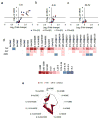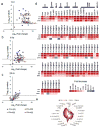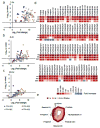Global assessment of oxidized free fatty acids in brain reveals an enzymatic predominance to oxidative signaling after trauma
- PMID: 28347845
- PMCID: PMC5612836
- DOI: 10.1016/j.bbadis.2017.03.015
Global assessment of oxidized free fatty acids in brain reveals an enzymatic predominance to oxidative signaling after trauma
Abstract
Traumatic brain injury (TBI) is a major health problem associated with significant morbidity and mortality. The pathophysiology of TBI is complex involving signaling through multiple cascades, including lipid peroxidation. Oxidized free fatty acids, a prominent product of lipid peroxidation, are potent cellular mediators involved in induction and resolution of inflammation and modulation of vasomotor tone. While previous studies have assessed lipid peroxidation after TBI, to our knowledge no studies have used a systematic approach to quantify the global oxidative changes in free fatty acids. In this study, we identified and quantified 244 free fatty acid oxidation products using a newly developed global liquid chromatography tandem-mass spectrometry (LC-MS/MS) method. This methodology was used to follow the time course of these lipid species in the contusional cortex of our pediatric rat model of TBI. We show that oxidation peaked at 1h after controlled cortical impact and was progressively attenuated at 4 and 24h time points. While enzymatic and non-enzymatic pathways were activated at 1h post-TBI, enzymatic lipid peroxidation was the predominant mechanism with 15-lipoxygenase (LOX) contributing to the majority of total oxidized fatty acid content. Pro-inflammatory lipid mediators were significantly increased at 1 and 4h after TBI with return to basal levels by 24h. Anti-inflammatory lipid mediators remained significantly increased across all three time points, indicating an elevated and sustained anti-inflammatory response following TBI.
Keywords: Cardiolipin; Docosanoids; Eicosanoids; Lipid peroxidation; Octadecanoids; Pro-resolving mediators.
Copyright © 2017 Elsevier B.V. All rights reserved.
Figures







References
-
- Faul XLM, Wald MM, Coronado V. N.C.o.I.P.a.C. Centers for Disease Control and Prevention, editor. Traumatic Brain Injury in the United States: Emergency Department Visits, Hospitalizations and Deaths, 2002–2006. Atlanta, GA: 2010.
-
- C.f.D.C.a. Prevention; N.C.f.I.P.a.C.D.o.U.I. Prevention, editor. Report to Congress on Traumatic Brain Injury in the United States: Epidemiology and Rehabilitation. Atlanta, GA: 2015. - PubMed
-
- Thurman DJ, Alverson C, Dunn KA, Guerrero J, Sniezek JE. Traumatic brain injury in the United States: A public health perspective. The Journal of head trauma rehabilitation. 1999;14:602–615. - PubMed
-
- Zaloshnja E, Miller T, Langlois JA, Selassie AW. Prevalence of long-term disability from traumatic brain injury in the civilian population of the United States, 2005. The Journal of head trauma rehabilitation. 2008;23:394–400. - PubMed
-
- Masel BE, DeWitt DS. Traumatic brain injury: a disease process, not an event. Journal of neurotrauma. 2010;27:1529–1540. - PubMed
Publication types
MeSH terms
Substances
Grants and funding
LinkOut - more resources
Full Text Sources
Other Literature Sources
Medical

